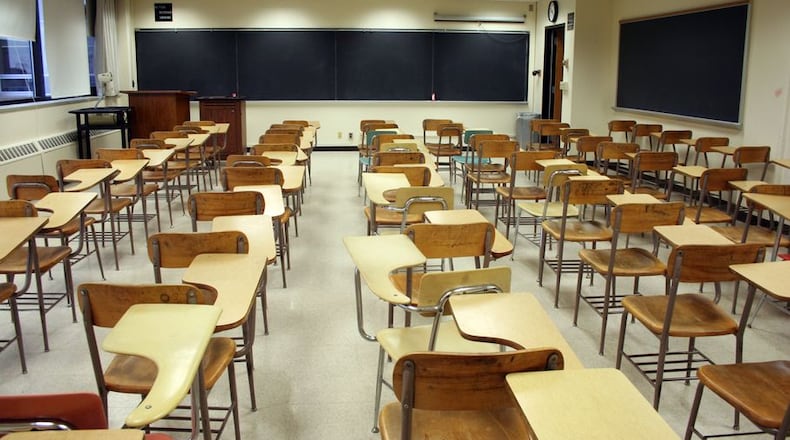A new analysis by the Center for American Progress looks at a national trend already apparent in Georgia; fewer college students are seeking teaching degrees.
CAP shows around a 40% decline in enrollment in Georgia teacher prep programs between 2010 and 2018. In that time period, only five states in the country -- Utah, Arizona, Washington, Texas, and Nevada -- experienced increases in student enrollment in teacher prep programs.
The report resists broad conclusions or proclamations. It notes state policies can drive localized teacher shortages. And it points out that researchers disagree on the causes of the teacher shortage that some districts confront.
For example, Richard Ingersoll of the University of Pennsylvania says, "The problem is not that we don't produce enough teachers We lose too many." Nationally, 44% of new teachers leave their jobs within five years. In Georgia, 32% leave within five years, according to Ingersoll’s research.
The Center for American Progress analysis addresses these differing views:
Beyond the rate at which teachers leave the profession, there is still much to learn about how supply and demand interact in teacher labor markets. While some researchers have created thorough projections of supply and demand of teachers nationally and concluded that a shortage is looming, other experts have disputed this prediction.
The proportion of teachers who are not fully certified is another indicator that researchers have used to argue that a national shortage is large and growing. According to the Economic Policy Institute, 1 in 10 teachers in high-poverty schools are not fully certified.
Furthermore, nearly 10 percent of schools reported that they were trying but unable to fill a vacancy in the 2015-16 academic year, up from 3.1 percent of schools reporting such difficulty in 2011-12. The findings were relatively similar for high- and low-poverty schools.
Aside from the potential that too few total students are completing teacher preparation programs to fill every classroom, there are other possible explanations for reports of persistent vacancies. One is that a portion of students who complete teacher preparation programs may not intend to teach or may decide after getting their degree that it is not the career for them.
The data show that this may be true for a small but significant portion of education majors. In a national survey, 69 percent of those who majored in education taught as a regular, full-time teacher in the five years after graduation, and an additional 16 percent taught in some other form, such as a substitute or teacher's aide. This leaves 16 percent of education majors who never taught in the five years after graduating with an education degree. However, some researchers have assumed that most students who prepare to teach plan to do so and concluded that only about half of preparation program graduates are able to find a full-time teaching position as a result of a continuing oversupply of teacher candidates.
The CAP report cites inconsistencies in how states collect information on teacher shortages, saying they differ in how and what they collect. Few states connect their teacher demand and the supply data.
However, the decline in enrollment in teacher prep programs should not be ignored, according to CAP:
The substantial decline in enrollment in teacher preparation programs nationally—as well as the more severe declines that become visible once the data are broken down by state, race and ethnicity, and subject—do not happen in a vacuum. Declining interest in the teaching profession may be related to a fundamental mismatch: The work is challenging and complex, but the pay, training, and prestige do not reflect this. College-educated professionals have other career options that provide them with better working conditions and pay and responsibilities that increase over the course of their career as they become more skilled in their chosen field. These differences are even more marked for students majoring in STEM fields or for students under more financial pressure, such as low-income students, first-generation college students, or students with a higher debt burden.
According to the analysis:
--Nationally, there were more than one-third fewer students enrolling in teacher preparation programs in 2018 than in 2010. Nearly every state in the nation has experienced declining enrollment in teacher preparation, with some states experiencing drastic declines of more than 50 percent.
--From 2010 through 2018, there was a 28 percent decline in students completing teacher preparation programs. Data on individuals completing teacher preparation programs reveal that from 2003 through 2013, there were more than 200,000 students completing teacher preparation programs; in 2018, however, fewer than 160,000 students completed such programs.
--Contrary to the overall decline in enrollment in other types of preparation programs, alternative preparation programs that are not based at institutions of higher education experienced an increase of more than 40 percent in enrollment between 2010 and 2018. Increasing enrollment in this type of program drove a slight uptick in national enrollment between 2016 and 2018.
--Disaggregating enrollment data by race and ethnicity shows that one-quarter fewer Black and Latinx teacher candidates were enrolled in teacher preparation programs in 2018 than in 2010. Enrollment declined by more than half for those who identified as Native Hawaiians or Pacific Islanders and American Indian or Alaska Native.
--When looking at enrollment by gender, the national percentage declines in enrollment were similar for male and female candidates, although the decline was steeper for men in most states.
--Programs for subjects with persistent teacher shortages, such as science, technology, engineering, and math (STEM) and special education, experienced declines in completion from 2012 to 2018. However, these declines were lower than the national decline in completers during the same time period. Notably, there was a 30 percent increase in completers who earned credentials for teaching English-language learners or bilingual education.
--At the national level, it remains difficult to estimate whether the total number of teacher preparation program completers is enough to fill the current need for new teachers. This is even more difficult to determine on a state-by-state basis due to the insufficient data currently collected.
About the Author
The Latest
Featured





